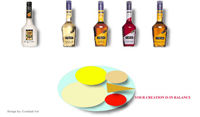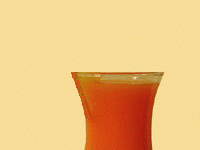The easiest way to understand this is to use only round flavours which always will fit simply in the circle, but which will also produce a simple and flat flavour. But perhaps as “bartender/artist”, we would want to build in an exciting detail, which will make the customer think:” What is that underlying flavour?!”
In this way the size of the geometrical figure corresponds to the quantity of the drink and the shape of the figure illustrates the taste. We can talk of sharp and round taste patterns.
In this way the following liqueurs will categories as non-accent flavours: peach, banana, melon, strawberry. However crème de menthe, coconut and amaretto are true accent flavours. The same is applicable to spirits: rum and vodka are true non-accent flavours, whereas a character-full gin is a definite accent flavour.





